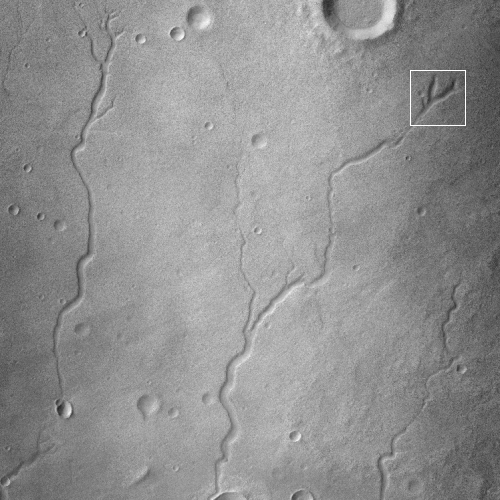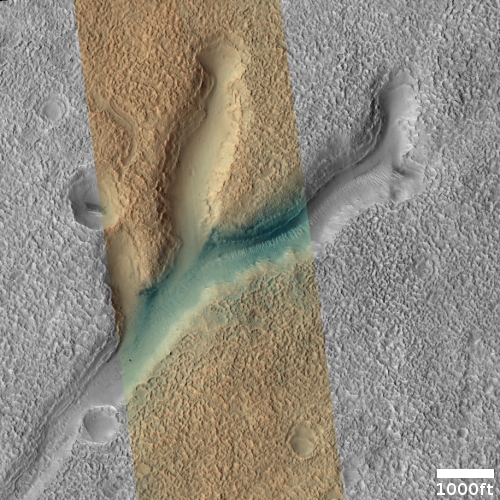Above ground and underground Martian drainages

Cool image time! Today we are going to zoom into our cool image. The overview map to the right provides us the context. Our target is the small white rectangle inside the small box just below the north rim of 185-mile-wide Newton Crater, located 200 to 800 miles from the southwest edge of the lava plains dubbed Daedalia Planum that flowed down from Mars’s biggest volcanoes.
Newton Crater has a number of interesting features. Only two weeks ago I featured 4-mile-wide Avire Crater in Newton’s western quadrant, long known to have many gullies on its interior slopes as well as glacier features on its floor. Scientists have been monitoring those gullies now for more than a decade to see if they change seasonally, in a attempt to figure out their cause.
Today’s cool image looks at the very intriguing meandering canyons that appear to flow south from Newton’s north rim.
The first photo to the right was taken on March 17, 2014 by the wide-view context camera on Mars Reconnaissance Orbiter (MRO). It covers the area of the small box in the overview above, and shows several of those meandering canyons, all of which strongly resemble river tributaries seen routinely on Earth. Unlike most Earth rivers, however, these canyons seem to begin very abruptly, rather than grow from tiny trickles into flowing rivers.
The second photo below is a MRO high resolution image, cropped and reduced to post here, that was taken on June 7, 2022. It covers the area in the white box on the context camera photo, and focuses in on the start of one of these canyons.
On Earth, such an abrupt beginning would suggest an underground resurgence in limestone or karst terrain. The water was flowing underground because limestone is essentially transparent to water. The water drops through it until it finds a more resistant layer, where it then flows sideways. When the surface exposes that layer, the flow appears as a spring or resurgence, and begins to flow along the surface.
It appears we have the same thing here, though no liquid water is presently visible. Nor is any obvious outlet visible at the canyon head. Instead it appears largely filled with Martian dust.
If you look very closely however at the overview map above, or zoom in on the context map at the link for the high resolution picture, you can see a much larger meandering canyon to the north and cutting through the eroded rim of Newton Crater. When it hits the crater floor it essentially vanishes.
If that larger northern canyon was formed by glacial ice or flowing water, these meandering smaller canyons to the south appear to be drainages that continue that southward flow. And the glacial evidence seen in Avire crater to the southwest inside Newton reinforces the possibility that these canyons are related to either glacial or liquid flows. The color strip in the hi-res image also reinforces this theory, as the blue colors in the canyon suggest [pdf] frost or ice, especially because the blue appears more intense on the north pole-facing cliffs.
On Christmas Eve 1968 three Americans became the first humans to visit another world. What they did to celebrate was unexpected and profound, and will be remembered throughout all human history. Genesis: the Story of Apollo 8, Robert Zimmerman's classic history of humanity's first journey to another world, tells that story, and it is now available as both an ebook and an audiobook, both with a foreword by Valerie Anders and a new introduction by Robert Zimmerman.
The print edition can be purchased at Amazon or from any other book seller. If you want an autographed copy the price is $60 for the hardback and $45 for the paperback, plus $8 shipping for each. Go here for purchasing details. The ebook is available everywhere for $5.99 (before discount) at amazon, or direct from my ebook publisher, ebookit. If you buy it from ebookit you don't support the big tech companies and the author gets a bigger cut much sooner.
The audiobook is also available at all these vendors, and is also free with a 30-day trial membership to Audible.
"Not simply about one mission, [Genesis] is also the history of America's quest for the moon... Zimmerman has done a masterful job of tying disparate events together into a solid account of one of America's greatest human triumphs."--San Antonio Express-News

Cool image time! Today we are going to zoom into our cool image. The overview map to the right provides us the context. Our target is the small white rectangle inside the small box just below the north rim of 185-mile-wide Newton Crater, located 200 to 800 miles from the southwest edge of the lava plains dubbed Daedalia Planum that flowed down from Mars’s biggest volcanoes.
Newton Crater has a number of interesting features. Only two weeks ago I featured 4-mile-wide Avire Crater in Newton’s western quadrant, long known to have many gullies on its interior slopes as well as glacier features on its floor. Scientists have been monitoring those gullies now for more than a decade to see if they change seasonally, in a attempt to figure out their cause.
Today’s cool image looks at the very intriguing meandering canyons that appear to flow south from Newton’s north rim.
The first photo to the right was taken on March 17, 2014 by the wide-view context camera on Mars Reconnaissance Orbiter (MRO). It covers the area of the small box in the overview above, and shows several of those meandering canyons, all of which strongly resemble river tributaries seen routinely on Earth. Unlike most Earth rivers, however, these canyons seem to begin very abruptly, rather than grow from tiny trickles into flowing rivers.
The second photo below is a MRO high resolution image, cropped and reduced to post here, that was taken on June 7, 2022. It covers the area in the white box on the context camera photo, and focuses in on the start of one of these canyons.
On Earth, such an abrupt beginning would suggest an underground resurgence in limestone or karst terrain. The water was flowing underground because limestone is essentially transparent to water. The water drops through it until it finds a more resistant layer, where it then flows sideways. When the surface exposes that layer, the flow appears as a spring or resurgence, and begins to flow along the surface.
It appears we have the same thing here, though no liquid water is presently visible. Nor is any obvious outlet visible at the canyon head. Instead it appears largely filled with Martian dust.
If you look very closely however at the overview map above, or zoom in on the context map at the link for the high resolution picture, you can see a much larger meandering canyon to the north and cutting through the eroded rim of Newton Crater. When it hits the crater floor it essentially vanishes.
If that larger northern canyon was formed by glacial ice or flowing water, these meandering smaller canyons to the south appear to be drainages that continue that southward flow. And the glacial evidence seen in Avire crater to the southwest inside Newton reinforces the possibility that these canyons are related to either glacial or liquid flows. The color strip in the hi-res image also reinforces this theory, as the blue colors in the canyon suggest [pdf] frost or ice, especially because the blue appears more intense on the north pole-facing cliffs.
On Christmas Eve 1968 three Americans became the first humans to visit another world. What they did to celebrate was unexpected and profound, and will be remembered throughout all human history. Genesis: the Story of Apollo 8, Robert Zimmerman's classic history of humanity's first journey to another world, tells that story, and it is now available as both an ebook and an audiobook, both with a foreword by Valerie Anders and a new introduction by Robert Zimmerman.
The print edition can be purchased at Amazon or from any other book seller. If you want an autographed copy the price is $60 for the hardback and $45 for the paperback, plus $8 shipping for each. Go here for purchasing details. The ebook is available everywhere for $5.99 (before discount) at amazon, or direct from my ebook publisher, ebookit. If you buy it from ebookit you don't support the big tech companies and the author gets a bigger cut much sooner.
The audiobook is also available at all these vendors, and is also free with a 30-day trial membership to Audible.
"Not simply about one mission, [Genesis] is also the history of America's quest for the moon... Zimmerman has done a masterful job of tying disparate events together into a solid account of one of America's greatest human triumphs."--San Antonio Express-News



